[When I saw Susan Fenton’s show, “Fatima,” now at SchmidtDean, I wondered whether she was thinking thoughts about the intersection between race and culture when she made the photographs. Her answer is, not exactly, and certainly not primarily. Here’s what she had to say about the work]:
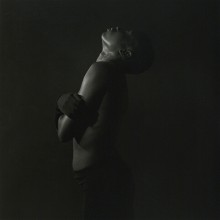 LR Why did you choose Fatima as a model?
LR Why did you choose Fatima as a model?
SF I was looking for a dark skin tone because I was going to do this body of work in black and white.
In Japan, I really liked the way their dark skin tone—caramel—looked with my dark backgrounds. Once I had Fatima [as a model], I became fascinated with the effort it took to differentiate tones within those darks. I wanted something someone was going to have to make some effort to see.
In my hand-painted work, there’s color and it makes it more like candy for the eyes…
LR Why no hand-painting now?
SF This was the first time I really set aside a project and said I’m going to do this. I always printed in black and white in my previous work, but it was conceived as a hand-painted image. That opened up the temptation to do work that would remain black and white. I also teach black and white, and I was jealous of my students [at. St. Joe’s].
Today, I just made my first digital print in black and white. I think I need to be prepared for that possibility that I will have to work digitally at some time in my career. The really large paper that I printed on is no longer easy to get. I have the digital print side by side with a gelatin silver print [from the same negative]. Ultimately I will get something I will be satisfied with. I do like the gelatin silver print better, but I’m not sure how much better. I may be able to get a closer match.
Dialog with the model
LR In working with a model, is there any kind of dialog that goes on in the process?
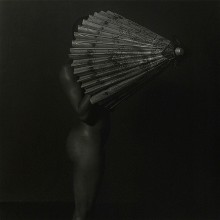 SF I always felt that way. Working with a model is a dialog or a dance. There is a certain amount of relinquishing the lead. And then there’s a dialog that takes place with the finished print and the audience and viewers. Fatima is the first model I’ve ever worked exclusively with.
SF I always felt that way. Working with a model is a dialog or a dance. There is a certain amount of relinquishing the lead. And then there’s a dialog that takes place with the finished print and the audience and viewers. Fatima is the first model I’ve ever worked exclusively with.
LR I’m not sure what you mean by exclusively.
SF The only person I photographed for eight or nine months. Usually I use three or four models in that period of time. This time I felt that the continuity was necessary. It was a breakthrough for me.
LR How was it a breakthrough?
SF The black and white print and using the same model, using the light to paint with instead of pigment.
Victorian decorations and darkness
LR I was startled by the image of the collar of flowers around Fatima’s neck. What did you have in mind when you used that?
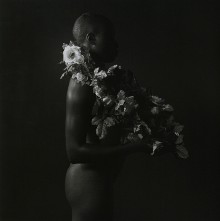 SF There was nothing profound in it at all. I had been working with flowers for a long time, more intensely in the late ’90s, the year 2000, deliberately using them to make frames that went around the face, head and shoulders of a model in the portrait format. Then I was thinking of the elaborate Victorian framing, either the decoration on the frame itself or the decoration vignetted around the portrait. I still have some of those flowers, wreaths and frames. I just included them as one of the props I played with, the light color of the flowers a conscious choice because of the darkness of the setting.
SF There was nothing profound in it at all. I had been working with flowers for a long time, more intensely in the late ’90s, the year 2000, deliberately using them to make frames that went around the face, head and shoulders of a model in the portrait format. Then I was thinking of the elaborate Victorian framing, either the decoration on the frame itself or the decoration vignetted around the portrait. I still have some of those flowers, wreaths and frames. I just included them as one of the props I played with, the light color of the flowers a conscious choice because of the darkness of the setting.
LR The first thing I thought of was a horse [draped with a similar-looking garland in the winner’s circle]. It made me uncomfortable.
SF Oh [pause]. I never thought of that. One thing I thought of was a lei. Or the May Day type garland.
LR I guess I was wondering what you meant by it.
SF It was not an issue for me. The only reason I wanted the black body was I had a dark background and I wanted a monotone.
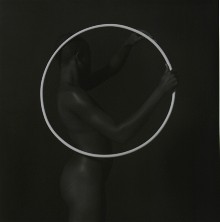 One of things, I wanted, was Fatima wrapped in a white cloth, also with a white hoop; the glow of the white against all that darkness was phenomenal. I’ve never quite seen that before! It is captured in those prints, the strobe reflecting off the white surface. At another time I had white wings—the white objects actually created a halo around themselves. But it might look to anyone who wanted to see it, black versus white. But I was just interested in the skin tones. [Fenton did not include some of these images from the series in the show].
One of things, I wanted, was Fatima wrapped in a white cloth, also with a white hoop; the glow of the white against all that darkness was phenomenal. I’ve never quite seen that before! It is captured in those prints, the strobe reflecting off the white surface. At another time I had white wings—the white objects actually created a halo around themselves. But it might look to anyone who wanted to see it, black versus white. But I was just interested in the skin tones. [Fenton did not include some of these images from the series in the show].
The body in fashion and ritual
LR When I saw this body of work, I thought about Mapplethorpe and how he sometimes used black bodies, how he lit them, and how he had a fashion component. I think of your work as raising issues about fashion.
SF I’m not sure what you mean by fashion.
LR I mean the look of the photo, the photograph isolating the body and what is on it against a plain backdrop to reify the clothes and the body.
SF If you mean fashion photography, I could say I played with some of that. I think it probably goes back to a time when I was just interested in somewhat artificial poses, Egyptian wall painting, the stiff poses that were a motif ; to me it was ritualistic imagery. My roots are there in images about ritualistic procedures. I saw it in Italy in Roman wall paintings, Etruscan, Greek wall paintings, Egypt in the tomb paintings. Then I came back to the United States in the mid ’80s and continued those very formal-type poses.
Then in the mid-’90s the fashion concept became something I was interested in, in and of itself, and the ritual was secondary. The last show, it was at SchmidtDean, was actually about how fashion covers the body and when you take it apart—when you cover some places, uncover others—you send a different message, accordingly. There’s something about the body adornment and the practicality of covering it, and I’ve always been interested in how the two play with each other and compete with each other. It can go into a sexual kind of thing. That interests me. I think I could say a titillation with fashion has always been there for me. Even the effects of the industry on people’s body image. I would like to do work addressing different kinds bodies.
LR Would you say ritual was part of the Fatima poses?
SF In some of the poses, the choices of the objects, simple basic forms. You mentioned the wreath as laurels in a way, and I guess one could see the hoop that way as well as jumping through hoops. There are vases, urns. Those suggest libations to me. Cloth over the arm, around the shoulders, the head, even over the entire figure has always been in my work because of its relation to ritualistic tradition.
I don’t believe in anything anymore but I still like to watch how it’s carried out—a procession, a bridal march, picking up an infant. There’s something that changes in the body, certain things in life that we handle with more care and certain transitions that we take more seriously. And we have rituals around those things that I find very fascinating. Death is one of them. Even the tea ceremony. You know I lived in Japan for three years. You sit a certain way, you turn a certain way, you pick up the vessel a certain way, you turn it… there’s something ludicrous but also something fascinating about it. It raises the act to a very different level, puts it on an altar.
Fatima’s input
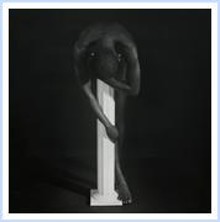 Fatima, when I started working with her, it was not my plan to keep the same model for the whole time. She is from Nigeria, came here when she was 18, and has a lot of tradition in her background. She was raised Muslim. There’s still a lot of tradition in her, too. She does yoga regularly. It was easy for her body to do the kind of things that I want to photograph. It was easy for her to move with me. That’s what I mean by a dance, with sometimes getting more out of me and sometimes more out of her.
Fatima, when I started working with her, it was not my plan to keep the same model for the whole time. She is from Nigeria, came here when she was 18, and has a lot of tradition in her background. She was raised Muslim. There’s still a lot of tradition in her, too. She does yoga regularly. It was easy for her body to do the kind of things that I want to photograph. It was easy for her to move with me. That’s what I mean by a dance, with sometimes getting more out of me and sometimes more out of her.
LR More out of her?
SF One big print of her over a pedestal, and she has her arm draped down over the pedestal, her foot on the bottom (image, above right). There’s another where she’s symmetrically, strategically placed behind the pedestal (that one was mine) (image, below left). We took a break and she shifted her pose to this more casual, elegant stretch, and we photographed it.
I think of it as a back and forth kind of think. I photograph [the models] once and see how they work on film. I did have to learn to work with Fatima’s features, and to work so exclusively with one model, I had to learn what I could do with her body, her movements. …The skin tone was what I was looking for. The rest came with that particular individual. We had a very good working relationship. She understood what I was trying to do and I understood what she could do, and that helped me get ideas of what I could do. I got to know how she naturally moved her body in front of a camera, how it fit in the square.
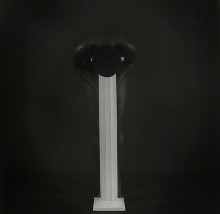 I typically start with sketches first. This is where the metaphor comes in. I go into the studio and make that happen. With Fatima, it wasn’t quite so necessary for me to do the drawings first, because I understood what she looked like within the square and how I could work with her.
I typically start with sketches first. This is where the metaphor comes in. I go into the studio and make that happen. With Fatima, it wasn’t quite so necessary for me to do the drawings first, because I understood what she looked like within the square and how I could work with her.
Incidental metaphors
LR Was there a metaphor with the Fatima series?
SF In previous work that was maybe more metaphoric than this, I’m constantly thinking of a given concept —from a sensation to an idea—and trying to turn it into something visual. No, I was just playing with the formal issues of composition. Sometimes things would just happen. But I didn’t sit down and think that I want to create an image of climbing up the back of an entire race of people, but when I brought the ladder to the studio and started playing with it, I thought this could suggest blah, blah, blah.
LR What’s next for you?
SF I spent the last three years photographing still life objects in low-light conditions, at night and during the full moon, using the moon as a light source. I’m excited about having the opportunity to finish that as a project. So far I have about 80 roles of film. Shooting opportunities are limited—a full moon, clear sky, be at home, get up in the middle of the night. I don’t know what I’ll edit it down to. The editing is a big factor in my work. To get 20 images, I will shoot 100 rolls of film.
LR How many did you shoot for Fatima?
SF I think I shot about 80 rolls—eight months, 10 rolls a month. I go through a lot of film.
LR How many do you print?
SF I shoot 12 images on a roll, medium format film, so 960 images. I would probably proof (a 5″ square enlargement), I would do a proof of maybe 1/3–maybe 300, 250–that I’m looking at more closely. From that I do an 8 by 10 inch proof (8 x 8 really on 8 x 10 paper) on fiber paper, which is what I’m going to do the bigger prints on. At that point, its more that just a proof; I’m burning and dodging. It’s less than half, maybe 80 to 100, and from that, I try to get it down to 20 or 40 prints. With Fatima, I ended up with 25 or 26 final prints.
LR How many of the shots duplicate one image?
SF Each roll is a given idea or pose. I would have been playing with the same toys no matter who the model was.









